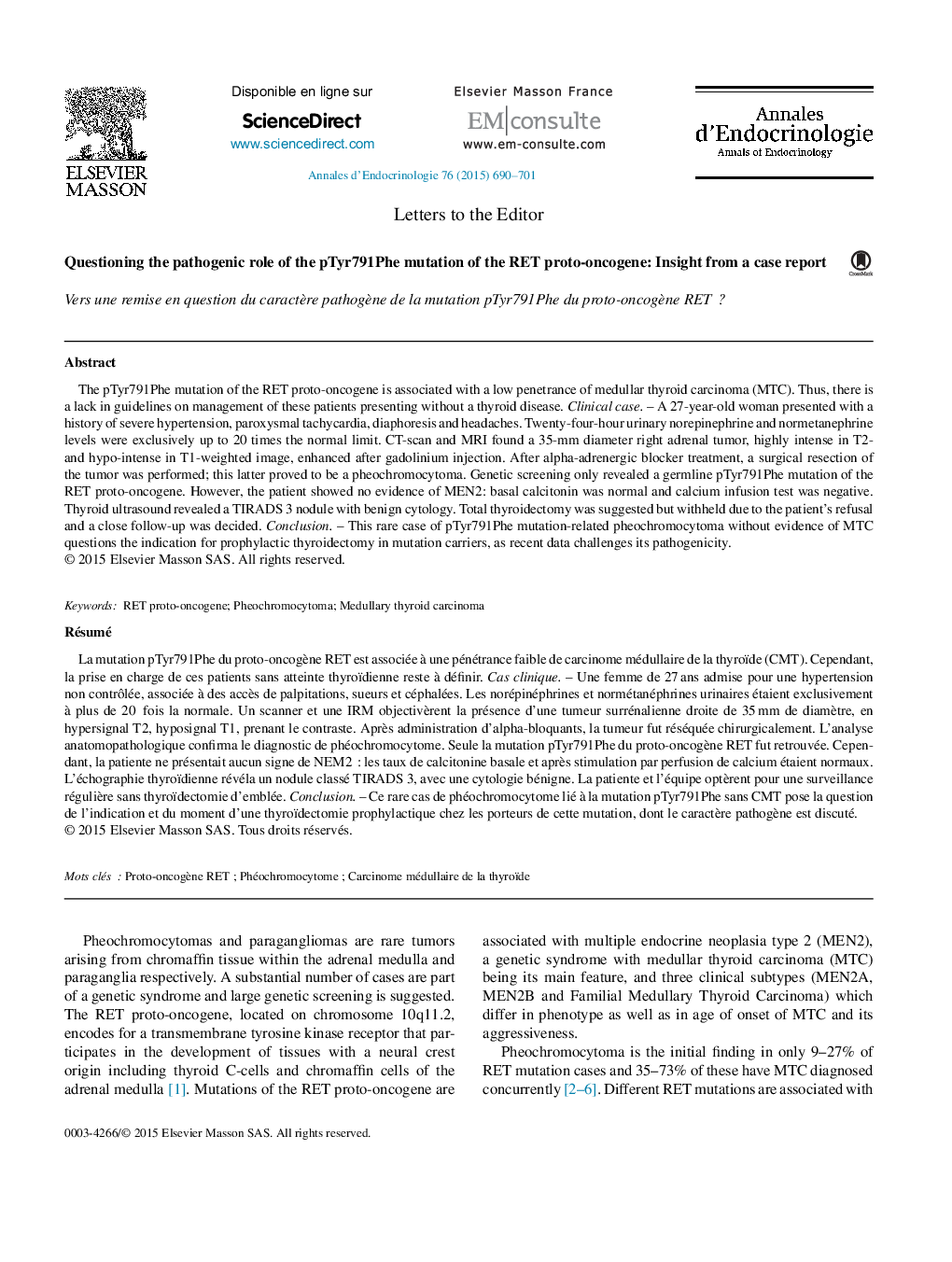| Article ID | Journal | Published Year | Pages | File Type |
|---|---|---|---|---|
| 3252158 | Annales d'Endocrinologie | 2015 | 5 Pages |
The pTyr791Phe mutation of the RET proto-oncogene is associated with a low penetrance of medullar thyroid carcinoma (MTC). Thus, there is a lack in guidelines on management of these patients presenting without a thyroid disease.Clinical caseA 27-year-old woman presented with a history of severe hypertension, paroxysmal tachycardia, diaphoresis and headaches. Twenty-four-hour urinary norepinephrine and normetanephrine levels were exclusively up to 20 times the normal limit. CT-scan and MRI found a 35-mm diameter right adrenal tumor, highly intense in T2- and hypo-intense in T1-weighted image, enhanced after gadolinium injection. After alpha-adrenergic blocker treatment, a surgical resection of the tumor was performed; this latter proved to be a pheochromocytoma. Genetic screening only revealed a germline pTyr791Phe mutation of the RET proto-oncogene. However, the patient showed no evidence of MEN2: basal calcitonin was normal and calcium infusion test was negative. Thyroid ultrasound revealed a TIRADS 3 nodule with benign cytology. Total thyroidectomy was suggested but withheld due to the patient's refusal and a close follow-up was decided.ConclusionThis rare case of pTyr791Phe mutation-related pheochromocytoma without evidence of MTC questions the indication for prophylactic thyroidectomy in mutation carriers, as recent data challenges its pathogenicity.
RésuméLa mutation pTyr791Phe du proto-oncogène RET est associée à une pénétrance faible de carcinome médullaire de la thyroïde (CMT). Cependant, la prise en charge de ces patients sans atteinte thyroïdienne reste à définir.Cas cliniqueUne femme de 27 ans admise pour une hypertension non contrôlée, associée à des accès de palpitations, sueurs et céphalées. Les norépinéphrines et normétanéphrines urinaires étaient exclusivement à plus de 20 fois la normale. Un scanner et une IRM objectivèrent la présence d’une tumeur surrénalienne droite de 35 mm de diamètre, en hypersignal T2, hyposignal T1, prenant le contraste. Après administration d’alpha-bloquants, la tumeur fut réséquée chirurgicalement. L’analyse anatomopathologique confirma le diagnostic de phéochromocytome. Seule la mutation pTyr791Phe du proto-oncogène RET fut retrouvée. Cependant, la patiente ne présentait aucun signe de NEM2 : les taux de calcitonine basale et après stimulation par perfusion de calcium étaient normaux. L’échographie thyroïdienne révéla un nodule classé TIRADS 3, avec une cytologie bénigne. La patiente et l’équipe optèrent pour une surveillance régulière sans thyroïdectomie d’emblée.ConclusionCe rare cas de phéochromocytome lié à la mutation pTyr791Phe sans CMT pose la question de l’indication et du moment d’une thyroïdectomie prophylactique chez les porteurs de cette mutation, dont le caractère pathogène est discuté.
